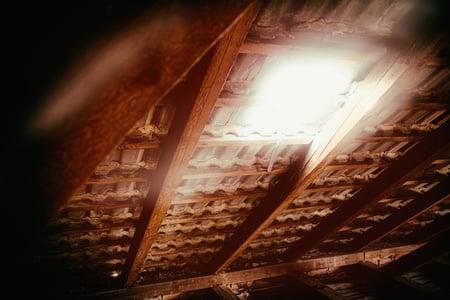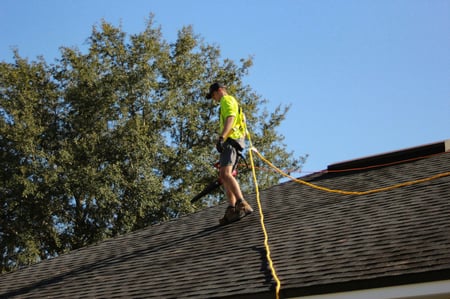How Proper Attic Ventilation Can Extend the Lifespan of Your Roof
June , 2024 | 6 min. read
By Mitch Owens

When thinking about maintaining your home, the attic might not be the first thing that comes to mind. We often tend to gravitate towards the things we see every day, like the crushed cereal your toddler threw on the floor that needs vacuuming, or the coffee stain on the kitchen counter.
I mean, why would we think about the attic until it’s time for the holiday decorations to come down? In all honesty, as much as we homeowners tend to overlook our attics, RoofCrafters can tell you that this space holds a critical key to the longevity of our roofs: proper ventilation.
So, if you’re curious about the role proper ventilation plays in your roof health, and how your attic is responsible for so much more than just a place to store grandma’s old trinkets you feel too guilty to donate, you’re in the right place! Let’s discuss all of the ways proper attic ventilation can extend the lifespan of your roof.
The Role of Attic Ventilation in Roof Health

Attic ventilation might sound like a mundane topic, (I mean, it kind of is) but it’s essential for the health of your roof and the comfort of your home. Proper attic ventilation involves a system of vents that allows fresh air to enter and stale air to exit. This process helps regulate temperature and moisture levels, which are crucial for maintaining the structural integrity of your roof.
Balancing Temperature and Moisture
During the summer, temperatures in an unventilated attic can soar up to 150 degrees Fahrenheit or more. This extreme heat can cause shingles to deteriorate prematurely and can warp the wooden frame of your roof. It can also raise your cooling bills as your air conditioner struggles to keep your living spaces comfortable.
In the winter, the opposite problem occurs. Warm air from your living areas can rise into the attic and, without proper ventilation, become trapped. This can lead to condensation forming on the underside of the roof deck, promoting mold growth and potentially causing wood rot. Moreover, improper ventilation in cold climates can lead to ice dams, which are harmful accumulations of ice that can damage shingles, gutters, and even the interior of your home.
The Benefits of Proper Attic Ventilation

So, how exactly does good attic ventilation benefit your roof? Let’s break it down:
- Extends roof lifespan: By preventing the extremes of heat and cold, good ventilation helps protect roofing materials from rapid aging and damage.
- Reduces energy costs: Proper airflow keeps your home cooler in the summer and reduces the load on your heating system in the winter, leading to lower energy bills.
- Prevents moisture damage: Ventilation reduces the risk of moisture buildup, which can cause mold, mildew, and rot.
- Improves indoor comfort: By regulating attic temperatures, your home stays more comfortable year-round.
- Prevents ice dams: Adequate ventilation minimizes the risk of ice dams in winter, protecting your roof and gutters.
Warning Signs of Poor Attic Ventilation

Wondering if your attic ventilation is up to par? Here are some signs that your attic might not be getting the air it needs:
- Excessive heat: If your attic feels like a sauna in the summer, it’s a clear indicator of poor ventilation.
- Moisture issues: Look for condensation on the roof deck or mold and mildew in the attic.
- Uneven roof temperatures: Ice dams on your roof in winter are a sure sign that your attic isn’t ventilated properly.
- Peeling paint: High attic temperatures can cause paint to blister and peel on the exterior of your home.
- Warped roofing materials: Warping or buckling of shingles can indicate extreme attic heat.
How to Ensure Proper Attic Ventilation

Ensuring your attic is well-ventilated involves understanding and installing the right types of vents. Here’s a list to get you started:
Types of Attic Vents
Types of Attic Vents- Soffit vents: These are installed under the eaves of your roof and allow cool air to enter the attic.
- Ridge vents: Placed along the peak of the roof, ridge vents let hot air escape.
- Gable vents: Installed on the gable ends of the attic, these vents allow air to flow through the attic.
- Roof vents: Installed on the roof surface, these can be static or powered to remove hot air.
- Attic fans: These are either solar or electrically powered fans that help expel hot air from the attic.
Calculating Ventilation Needs
To ensure effective ventilation, you’ll need to calculate the right amount of vent area for your attic. The general rule of thumb is a ratio of 1:300, meaning one square foot of ventilation for every 300 square feet of attic floor space. This should be split evenly between intake vents (such as soffit vents) and exhaust vents (like ridge vents). But, you won't need to worry about that - your roofer will take care of the calculations for you!
DIY vs. Professional Installation
While some ventilation tasks, like installing gable vents, might be suitable for a seasoned DIY enthusiast, other tasks, such as calculating the proper ventilation ratio or installing ridge vents, are best left to professionals. If you've been around the RoofCrafters Learning Center for a while now though, you all know our team advises against DIY projects! Unless it involves arts and crafts, of course.
Long-Term Benefits of Proper Attic Ventilation

Investing in proper attic ventilation isn’t just about preventing immediate problems; it’s about safeguarding your home’s value and ensuring a comfortable living environment for years to come. Check out these 3 key reasons for the why and how:
1. Energy Efficiency and Comfort
When your attic is properly ventilated, it helps maintain a stable indoor temperature, reducing the need for heating and cooling. This not only cuts down on energy bills but also reduces your home’s carbon footprint, contributing to a greener environment.
2. Structural Integrity
Moisture is one of the biggest enemies of your roof’s structural integrity. By preventing condensation and ensuring that your roof deck stays dry, proper ventilation helps maintain the strength and stability of your roof’s framework. This reduces the likelihood of costly repairs and extends the overall lifespan of your roof.
3. Improved Indoor Air Quality
Good ventilation reduces the risk of mold and mildew, which can affect the air quality in your home. A well-ventilated attic prevents these allergens from spreading, ensuring a healthier living space for you and your family.
Ensuring Roof Longevity Through Effective Attic Ventilation
At the end of the day, proper attic ventilation is not just a generally good idea, it’s a critical aspect of roof maintenance that can significantly extend the lifespan of your roof! By managing heat and moisture levels, you protect your roof’s structural integrity, enhance energy efficiency, and improve indoor air quality.
Whether you’re building a new home or maintaining your current abode, prioritizing attic ventilation will pay off in the long run, keeping your roof in top shape and your home comfortable year-round. I mean, who doesn’t love a moisture-free, temperature-controlled home?
So, be sure to invest in proper attic ventilation, and give your roof the breath of fresh air it needs to stay strong and last longer. If you have an inkling that your attic may not be taking care of its duties, be sure to hit the “Schedule an Inspection” button down below, and one of our experts will take a look as soon as possible!
My name is Mitch, and I have over 10 years of roofing experience. I enjoy my career in the service industry because I love helping others take care of their homes and businesses. With over 10 years in the roofing industry, my success comes from my honesty and integrity during my roof inspections. I do my best to listen to the needs of my clients and strive to provide an awesome client experience.



